#Pacific Northwest Coast art
Text
#WoodpeckerWednesday:

Woodpecker, 1974
Art Thompson (Canadian, Ditidaht, Nuu-Chah-Nulth, 1948-2003)
serigraph, 58.5 x 44.4 cm
Art Gallery of Greater Victoria 1998.035.024
#animals in art#20th century art#birds in art#illustration#bird#birds#woodpecker#First Nations art#Canadian art#Indigenous art#seriograph#Pacific Northwest Coast art#Woodpecker Wednesday#Art Gallery of Greater Victoria#1970s
68 notes
·
View notes
Text
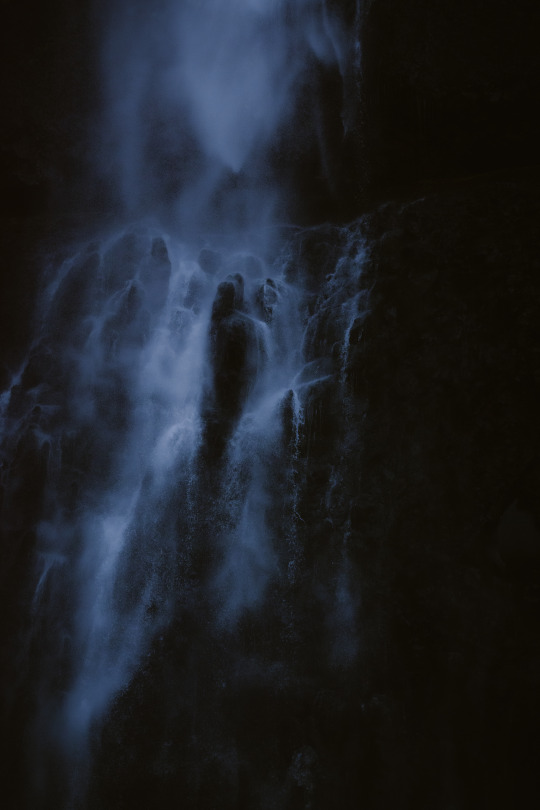
mvdso
#forestcore#dark#dark and moody#oregon#goth#nature#darkcore#moody#forest#photography#multnomah county#multnomah falls#multnomah#pnw#pnw gothic#my photography#pnwonderland#pnw vibes#nature photography#washington#trees#pnw photography#pacific northwest#pnw aesthetic#pnw coast#washington state#dark academia#dark grunge#dark art#dark aesthetic
168 notes
·
View notes
Text
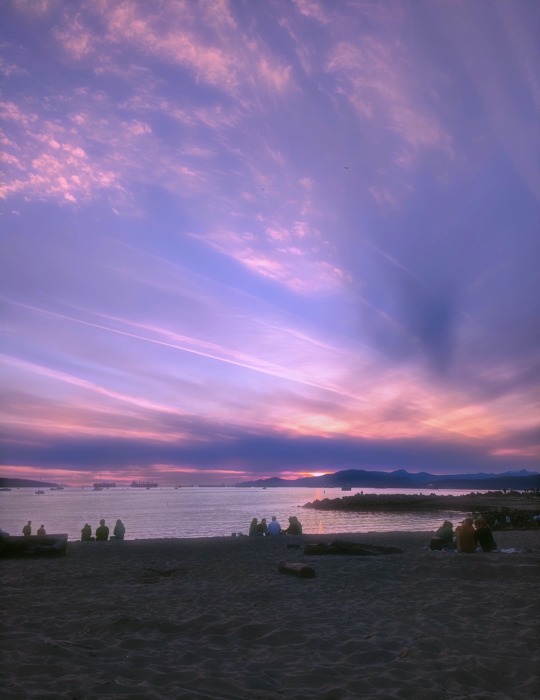
#nature#summer#floral#photography#love#beautiful#flowers#sky#art#cottagecore#cottage aesthetic#beach#west coast#pacific northwest#vancouver#artists on tumblr
45 notes
·
View notes
Text




Rain or shine, the Pacific Northwest is divine.
Ps, I am the tiny person next to Haystack Rock
#oregon#mt hood#portland#haystack rock#cannon beach#pacific northwest#pnw photography#autumn#cascadia#beautiful#fall aesthetic#scenic highway#portland oregon#Oregon coast#indian beach#west coast#northwest coast#travel photography#art#oregon photography#the great pnw#pnw aesthetic#pnwadventures#twilight#twilight Oregon#the goonies#aesthetic#new moon#eclipse#Astoria
45 notes
·
View notes
Text


Killer Whale Pod of Many Nations (2006)
by Odin Lonning (Tlingit)
carved cedar with acrylic
The seven-foot-long red cedar carving of five killer whales in five Northwest Coast Native art styles is a tribute to endangered orcas and Coastal tribes from Puget Sound to Alaska.
The Tlingit whale denotes how a crest originates in the story of Natsiclané, or Creation of the Killer Whale. The Haida whale embodies two stories about the Raven-Finned Killer Whale and the adventures of Nanasimgit and His Wife. The Nuu-chah-nulth whale signifies the timeless wolf-killer whale connection in their culture and commemorates Tsux’iit (Luna).
The Kwakwaka’wakw whale celebrates the triumphant reunion of Keetla (Springer) with her pod in Namgis First Nation territory in British Columbia. A vocal delegation of “Springer’s Peeps” cheered enthusiastically for this whale, which shows Springer spyhopping. The Coast Salish whale pays homage to the Indigenous peoples and Southern Resident orcas of the Salish Sea.
Killer Whale Pod of Many Nations: “Carving for a Greater Cause” by Ann Stateler, for WHULJ, The Newsletter of the Puget Sound Chapter of the American Cetacean Society, Winter 2007 (PDF here)
This piece was made possible by a Native Arts grant from the Potlatch Fund.
On display at the Seattle Aquarium, in the Puget Sound Orcas Family Activity Center
Photograph 1 by Scott Beale / Laughing Squid
Photograph 2 by Bryan Lor / Adventures of BL
#kashoplili#tlingit#coast salish#namgis#indigenous#native american#puget sound#first nations#haida#Kwakwaka’wakw#Nuu-chah-nulth#tradish#tradishional art#orca whale#killer whale#seattle#pnw#pacific northwest#northwestern
24 notes
·
View notes
Text

Cape Perpetua 4
#pnw#pacific northwest#positive vibes#explore#photo of the day#oregon coast#oregon#lensblr#photography#wanderlust#love#landscape#aesthetic#beautiful#art#cool#awesome#travel#artists on tumblr#original photographers#original photographer#photographers on tumblr#photographer on tumblr#nature#my photography#my photos#photo
37 notes
·
View notes
Text
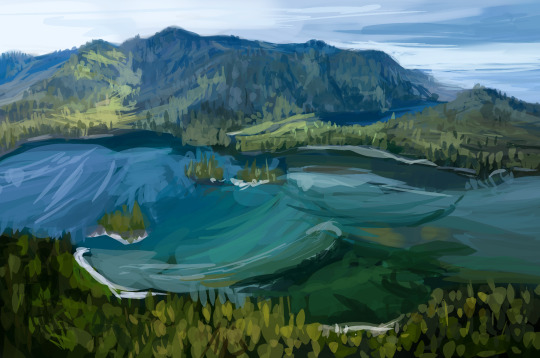
By the seaside - old study
#my art#landscape#landscape art#concept art#environment art#seaside#coast#Pacific Northwest#landscape painting
3 notes
·
View notes
Photo

Okay, so I kinda cheated on today's "domestic/tame lizard" Zooly prompt, since people don't commonly keep northern alligator lizards (Elgaria coerulea) as pets. But I saw one on a recent hike and was inspired to recreate its scaly beauty.
Ink pen and Copic markers.
#Zooly#Zooly Art Challenge#alligator lizard#northern alligator lizard#lizards#reptiles#herps#herpetology#Pacific Northwest#west coast#wildlands#animals#nature
15 notes
·
View notes
Text

Herons stacked on top of each other
We saw a lot of herons on our recent camping trip and Micah, my brother-in-law, was saying something about the herons that I can't remember now, but in the moment my brain filled in the rest of his sentence with "Herons stacked on top of each other," so that's what I painted while we were camping, with the background based on how it actually looked that first evening (and often the rest of the time; tho this photo is from the next morning when the fog had receded more).

#traditional#art#watercolor#watercolour art#painting#herons#heron#birds#pnw#pacific northwest#pacific coast#fog#drawing#ink#pen and ink#micron#sketches and studies#backpacking#camping#plein air#art blogging
0 notes
Text
Nehalem State Park, Oregon. Video taken by Dr. Deanna Grimstead.
#state park#oregon#oregon coast#ocean aesthetic#ocean art#pacific northwest#pacific ocean#winter storm
1 note
·
View note
Text
#Woodensday:
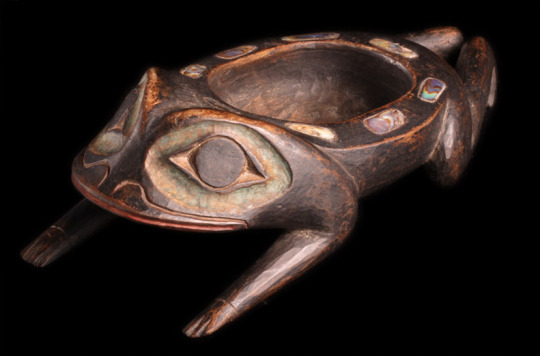

Frog Bowl, c.1860
Tlingit culture, Pacific NW Coast
Wood, Paint & Abalone Shell, 7½ Length
The Steven Michaan Collection of North American Tribal Art
“Frogs were principal characters in many traditional stories that were (and still are) part of the oral history of Tlingit culture.
Like the character of the prince in shining armor in Western literature and children's stories, the frog was the character who rescued maidens from ordinary lives and magically transported them to another existence, in this case a watery underworld paradise where they were celebrated as princesses and queens.
To the shaman, the frog was equally important as both an illustrative example and a "yei", a spiritual helper. Like the shaman who existed in the physical world and made frequent passages to the spirit world, the amphibian frog comfortably existed in both the terrestial and aquatic worlds with equal mastery, with each environment providing the from with different skills : ie., hopping on land, and swimming under water. This parallel made for easily understood "medical" explanations of shamanic healing practices of earthly illness, which were thought to be remediable only in the spirit world.
While the exact purpose of this bowl or container is not known, it could easily be a shaman's carrying case for small objects or could possibly be a dowry box to be given to a maiden on the occasion of her wedding.
Technically, the piece is delicately carved and broadly detailed so as to represent all frogs and pay honor to them. The piece is unusual in that it represents a single creature without any of the combinations and metamorphisms that unite multiple spirits, characters and creatures in single sculptures.
Extravagantly set with abalone and masterfully carved, the object was either from a family of great wealth and cultural status or a shaman with sufficient resources to commission such a carving or produce it himself.”
#animals in art#19th century art#Tlingit art#Pacific Northwest Coast art#indigenous art#First Nations art#Native American art#woodwork#bowl#frog#Woodensday
52 notes
·
View notes
Text

We are in the Field Museum's Northwest Coast.
The Results are in… AI Art is 50 Seconds while Amateur Artist is 24 Minutes and 44 Seconds.
DO THE DRAWING WITH REAL ARTISTS, Help Stop AI Art in the Future.
I'll be Labeling "AI Art" on Images.
0 notes
Text

Kitsilano
#nature#summer#floral#photography#love#beautiful#flowers#sky#art#bc#british columbia#west coast#cottage aesthetic#cottagecore#cozycore#cozy aesthetic#cozy cottage#pacific northwest
24 notes
·
View notes
Text

"Ode to the Newport Oregon Undersea Gardens" (2022) & "The Wa-Wa" (2021).
VariegatedWonders {Instagram}
#I am the artist#mermaidcore#oceancore#sea#coast#ocean#pacific ocean#pnw#beach#pacific northwest#Marine life#Aquatic#Aquarium#Painting#Acrylic#Art#Sea shore#Shore#Iridescent-Scales#VariegatedWonders
1 note
·
View note
Note
Which legendary Cryptids are appropriated from Indigenous Alaskan/American/Canadian/ cultures?
Honestly, most of them.
Wend!g0: appropriated from Algonquian cultures. The word itself (at least this version that I've censored) is Ojibwe & is an evil cannibal spirit
Sk*nwalkers: Navajo. Evil medicine men
Ravenmockers: Cherokee, called the Kâ'lanû Ahkyeli'skï in the Native language
Deer Woman: various cultures, including Ojibwe, Cherokee, Seminole, Oceti Sakowin, Haudenosaunee, & more.
Bigfoot/Sasquatch/various other giant hairy humanoids: various cultures, especially the Pacific Northwest. My culture also has them, & they're called Mistapew in our language. The word & "cryptid" Sasquatch is a bastardization of the word (& spirit) se'sxa from a Salish language (might be Nlaka'pamuctsin).
Lake Eerie Monster/Ogopogo/various other lake monsters: based on Algonquian horned serpent spirit & other similar spirits. Ogopogo in particular was stolen from the Secwepemc spirit Naitaka & the Sylix spirit nx̌ax̌aitkʷ
Thunderbirds: frequently found in many cultures, but most popular in Pacific Northwest Coast cultures, as evident in their art. Also found in some Algonquian cultures, including mine, & my Cree name has this word in it. This one was just straight up stolen & had a "cryptid" label slapped onto it
Caddy/Cadborosaurus: found in various PNWC cultures, called the hiyitl'iik by the Manhousat people, t'chain-ko by the Sechelt, & numkse lee kwala by the Comox in Vancouver.
Skunk Ape: bastardization of the Seminole Esti Capcaki, fitting the same description.
Shunka Warak’in: based on the name, it sounds like it was stolen from Oceti Sakowin legends, since "Shunka" (šúŋka) means "dog", particularly in Lakota
Adlet: stolen from Inuit legends
Thetis Lake Monster/Canadian Lizard Man: very likely based on & stolen from Haida Gwaii legends
Michigan Dogman: might be a mixture of Odawa legends as well as overlap with wend!g0
Owyhee Mountain Dwarves: stolen from Shoshone and Bannock legends
Nain Rouge: bastardization mix between French folklore called the lutin, and Native legends local to the area
Wampus Cat/Wampus: appears in multiple cultures, including Cherokee.
La Llorona: this one may have been influenced by a "weeping woman" figure that is seen in a few central american cultures, like Cihuacōātl, who has a really similar story with her son Mixcoatl.
Piasa Bird: spirit from Mississippian culture, often depicted in murals and art, including at Cahokia
Pukwudgie: from Wampanoag legends, & is a Wampanoag word. I think similar spirits exist elsewhere
A cryptid is an animal or creature that may or may not biologically exist but has a lot of tall tales surrounding it, and so people into "cryptids" (specifically ones that are appropriated) will use Native legends to fuel their argument & use as "proof" that these "animals" exist/existed, rather than the other way around that these are actually Native spirits that White people got a hold of, decontextualized, bastardized, and then spread inaccurately as "cryptids" or simply "folklore", with the latter being correct. Or people who think that these are just fun stories think "here's a cryptid and oh hey here's a Native spirit fitting the exact same description and the area the cryptid originates from is in the traditional territory as the Native culture this Native spirit is from. It's just a coincidence." & don't think it's because of appropriation at all.
I'm very likely missing some so there's probably more, but I also wouldn't be surprised if multiple OTHER "cryptids" have their origins in Native spirits that we haven't investigated yet. I've also been seeing White people talk about "cryptids" and then just straight up listing Native spirits, even ones that aren't widely known and don't even have a history of being called "cryptids". Which is fucking racist.
Native spirits aren't cryptids.
5K notes
·
View notes
Text
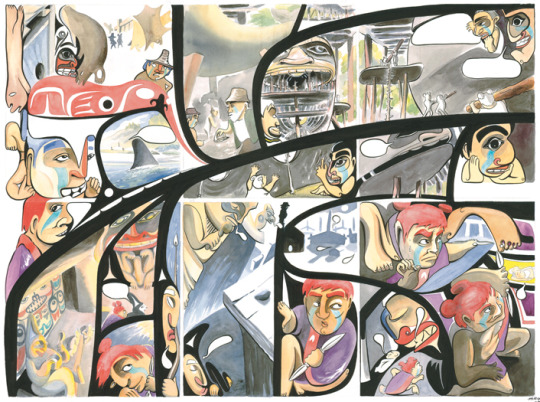
Red: A Haida Manga - Sheet 07
Michael Nicoll Yahgulanaas
from the website:
Michael Nicoll Yahgulanaas (Haida) is known for pioneering the hybrid “Haida Manga” style. “Manga” are Japanese-style comics that developed out of ancient caricatures, illuminated scrolls, brocade prints, and were influenced by the arrival of American and European comics after World War II. Yahgulanaas’ hyper-kinetic drawings combine the bold lines of traditional Northwest Coast design and the narrative form of manga, to retell the family legends in a genre-bending, mind-twisting way. The combination of these two cross-Pacific cultural artforms is an exhilarating and successful genre pairing that he has explored across multiple media.
Yahgulanaas’ masterpiece is the 18-panel, 15ft long narrative mural, RED. Painted in 2009, RED was the culmination of two years of storyboarding and three months of painting. Yahgulanaas’ art is chameleonic throughout, showing tell-tale influences from Hokusai to Eisner, MAD Magazine to Edenshaw to Picasso.
This open edition run of prints debuts with Stonington Gallery. Each sheet represents two sections of RED’s narrative, and comes with a reproduced artist’s signature. Printed on high quality watercolor paper, the prints have been color-matched to the original watercolor masterpiece. The full mural is 18 sheets, though they may be purchased individually.
The plot is based on a story from Yahgulanaas’ family. Red and Jaada are orphans growing up on Haida Gwaii. When Jaada is captured by raiders from another village, Red swears to recover her. Red becomes leader of his village, but can think of nothing but his missing sister, and brings his people to the brink of war and disaster in his quest for revenge.
Yahgulanaas made his formal American debut in 2015, with a solo exhibit at Stonington Gallery, displaying RED at SAM, and having work enter the collection of the Metropolitan Museum of Art. Limited and open edition prints of RED are available through Stonington Gallery. A book form of RED is available through booksellers.
Click here for a digital edition of the catalog
64 notes
·
View notes